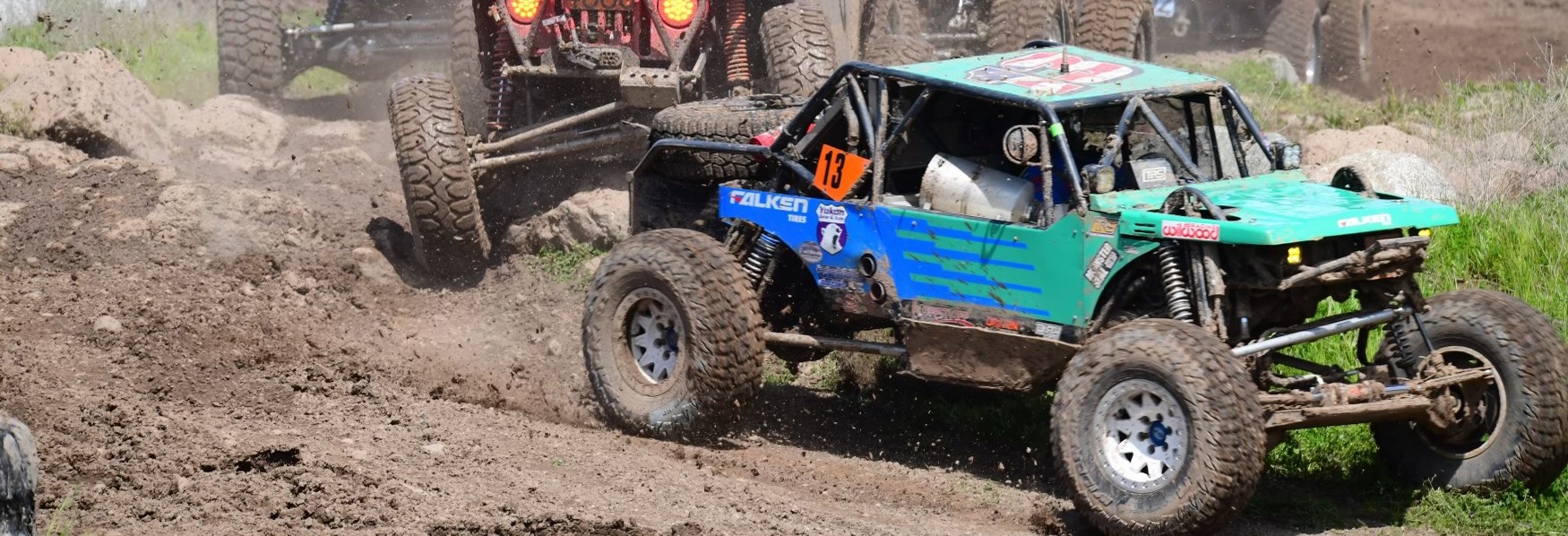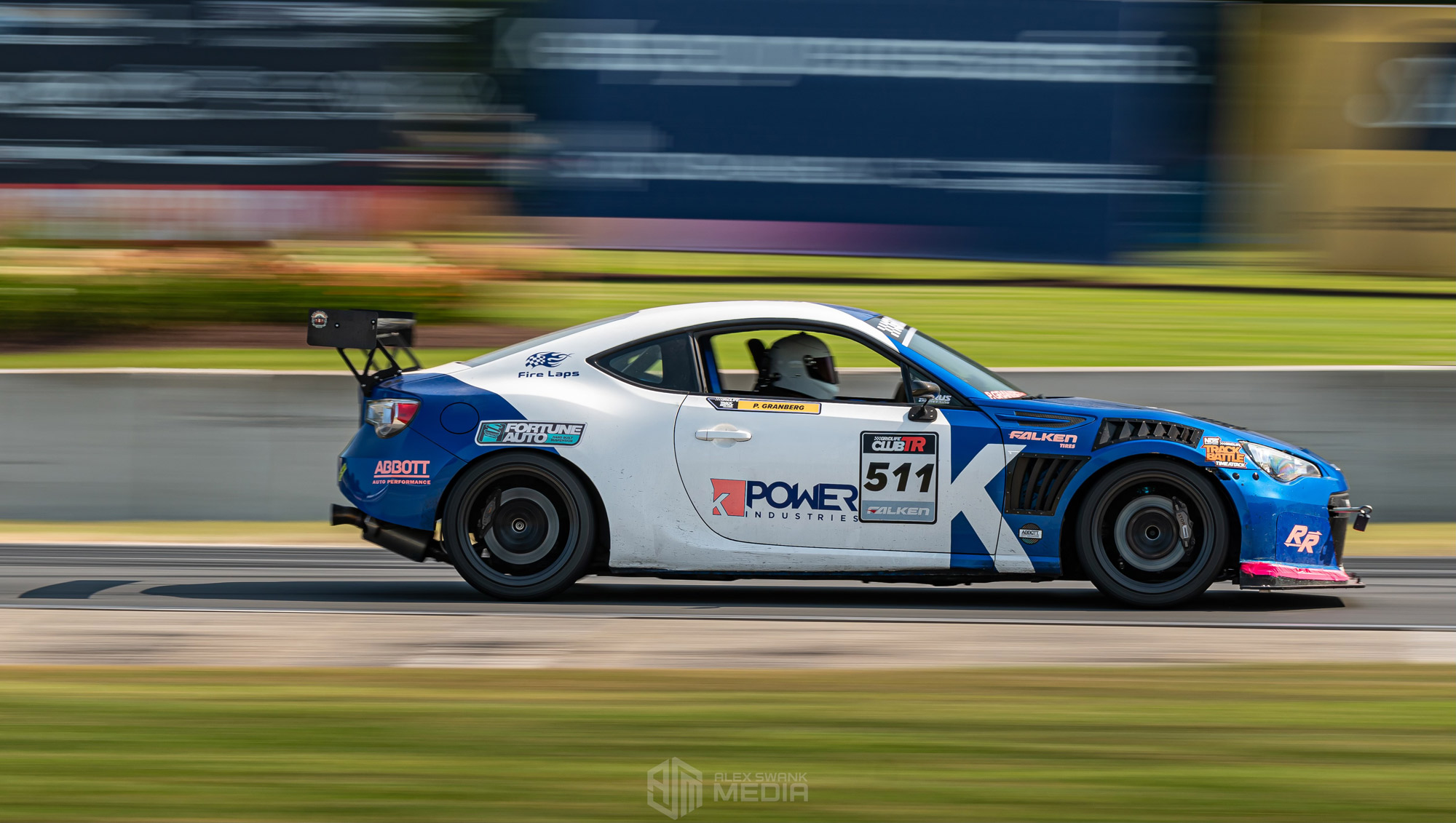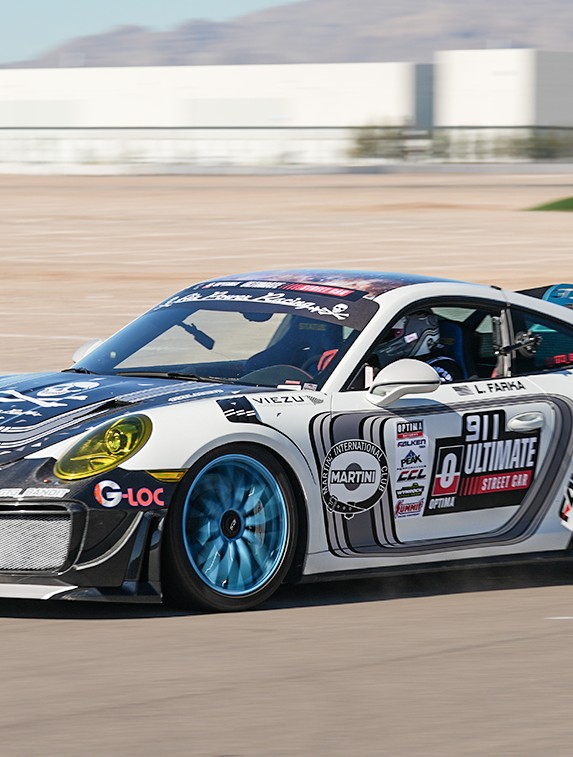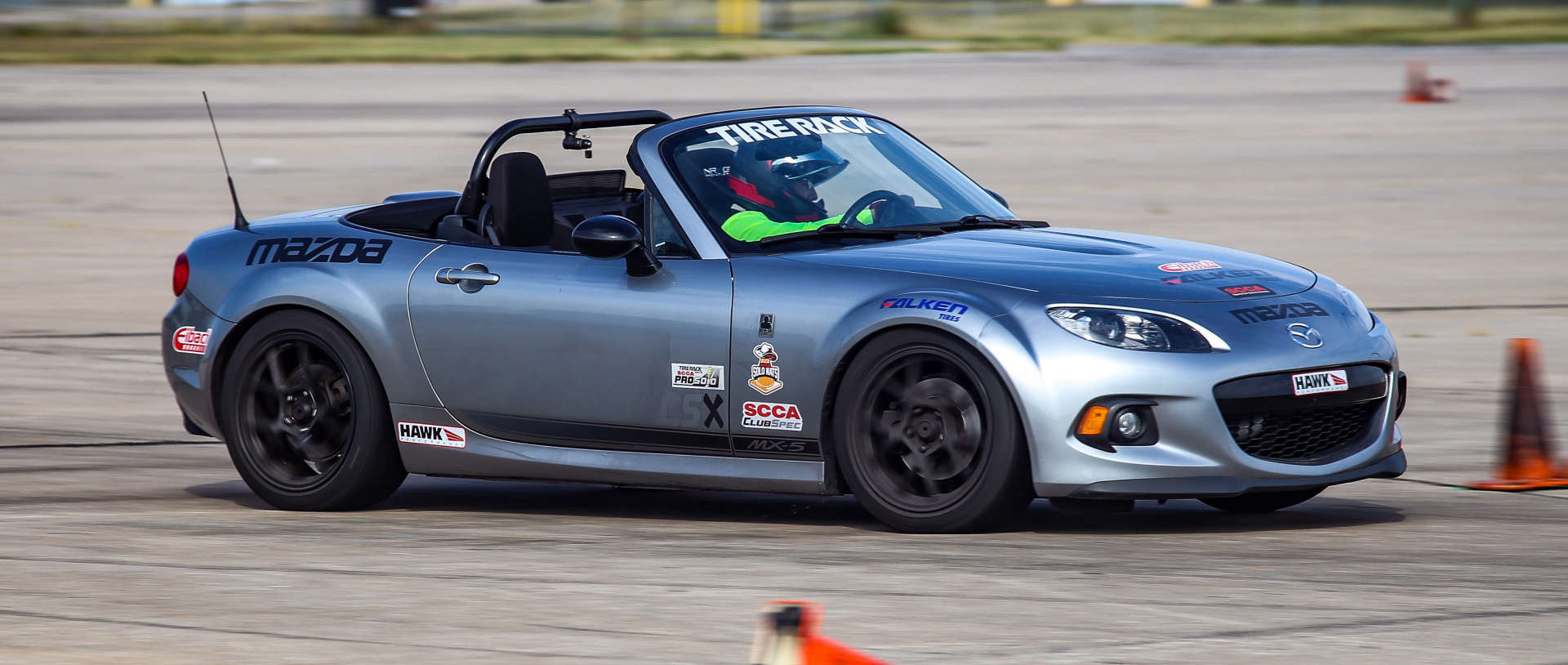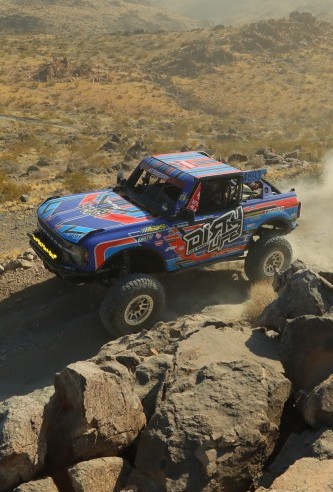Community - RAM 1500 Rebel 35 Inch Tires, Best Tire Pressure, Towing Setup | Falken Tires
RAM 1500 Rebel 35 Inch Tires, Best Tire Pressure, Towing Setup
Updated: November 4, 2024
In this episode of 'Will It Fit?' with Falken Tires, we ask a Falken employee how he set up his 2020 RAM 1500 Rebel with Falken's Wildpeak R/T hybrid terrain tires. Can you fit 35s on a 5th gen RAM 1500 Rebel? What tire pressure should you run for daily driving, towing, and off-road? What else can you do to make your truck more capable, comfortable, and long-lasting? Check out the post below to learn this and much more.
Section Breakdown (Click to Jump Directly to Each Section)
Tire Size
LT285/75R18 vs. 35x12.50x17 Tire Size
Wildpeak R/T (Hybrid Terrain Tire)
Effects of Changing from RAM 1500 Rebel Original Tire Size - 275/70R18
Ensuring Tires Can Support Truck Towing Capacity
What Else You Can Do to Make Towing Easier
Tire Pressure For Daily Driving (Not Towing)
Tire Pressure When Towing
Load Range E Tires Needed For Heavy Towing
Tire Pressure When You Off-Road
Why Choose the RAM 1500 Rebel
What MPG Do You Get With Bigger Tires?
Other Accessories For RAM 1500 Rebel
Video Transcript Below
Jeremy, Falken Tires: Ready to roll? All right, YouTube, we're back with another episode of Will It Fit? I'm here with Eusebio, who hails from our IT Department, because Falken is for enthusiasts by enthusiasts.
RAM 1500 Rebel with 35 inch Tires - LT285/75R18
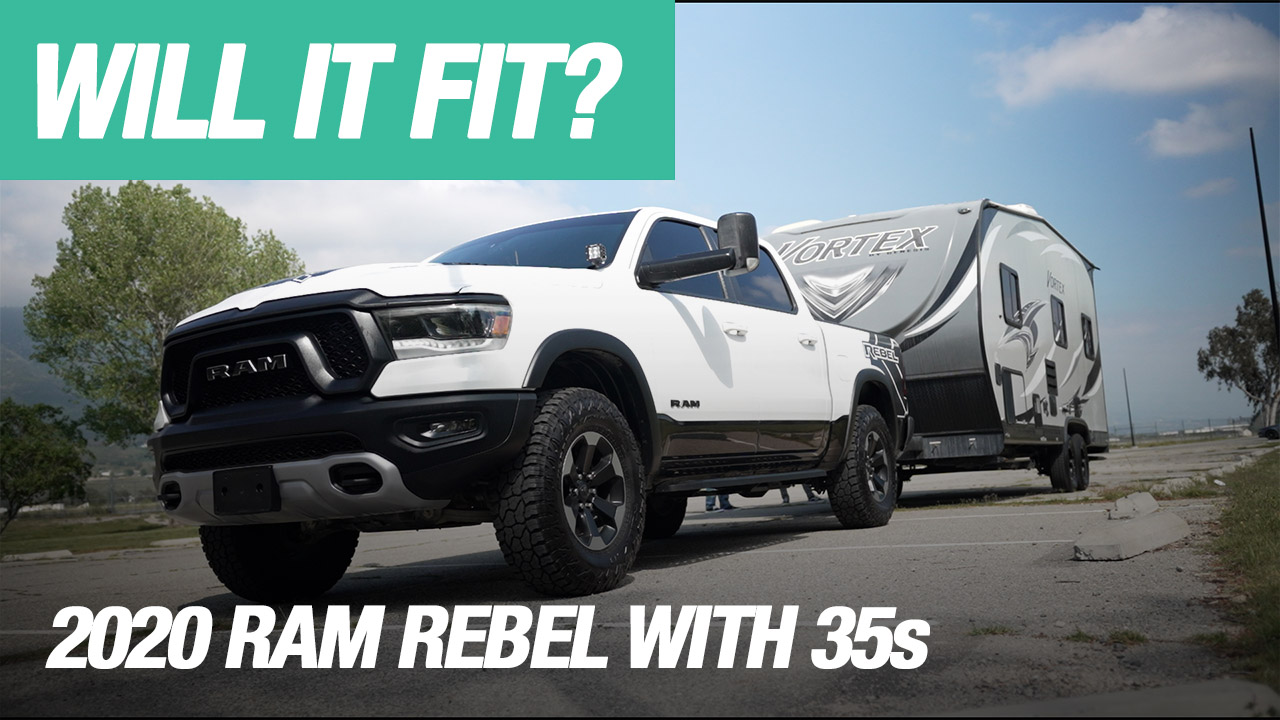
Jeremy: So, Eusebio, let's start from the top. What are we driving here?
Tire Size
Eusebio, Falken Tires: We have a 2020 RAM 1500 5th Gen. It is the Rebel edition. So it already comes with a one inch lift from factory. So that, kind of helped a little bit with fitting this 35 inch. Keep in mind, it's not a true 35 in the sense that it's a 35x12.50, but it's actually a LT285/75R18.
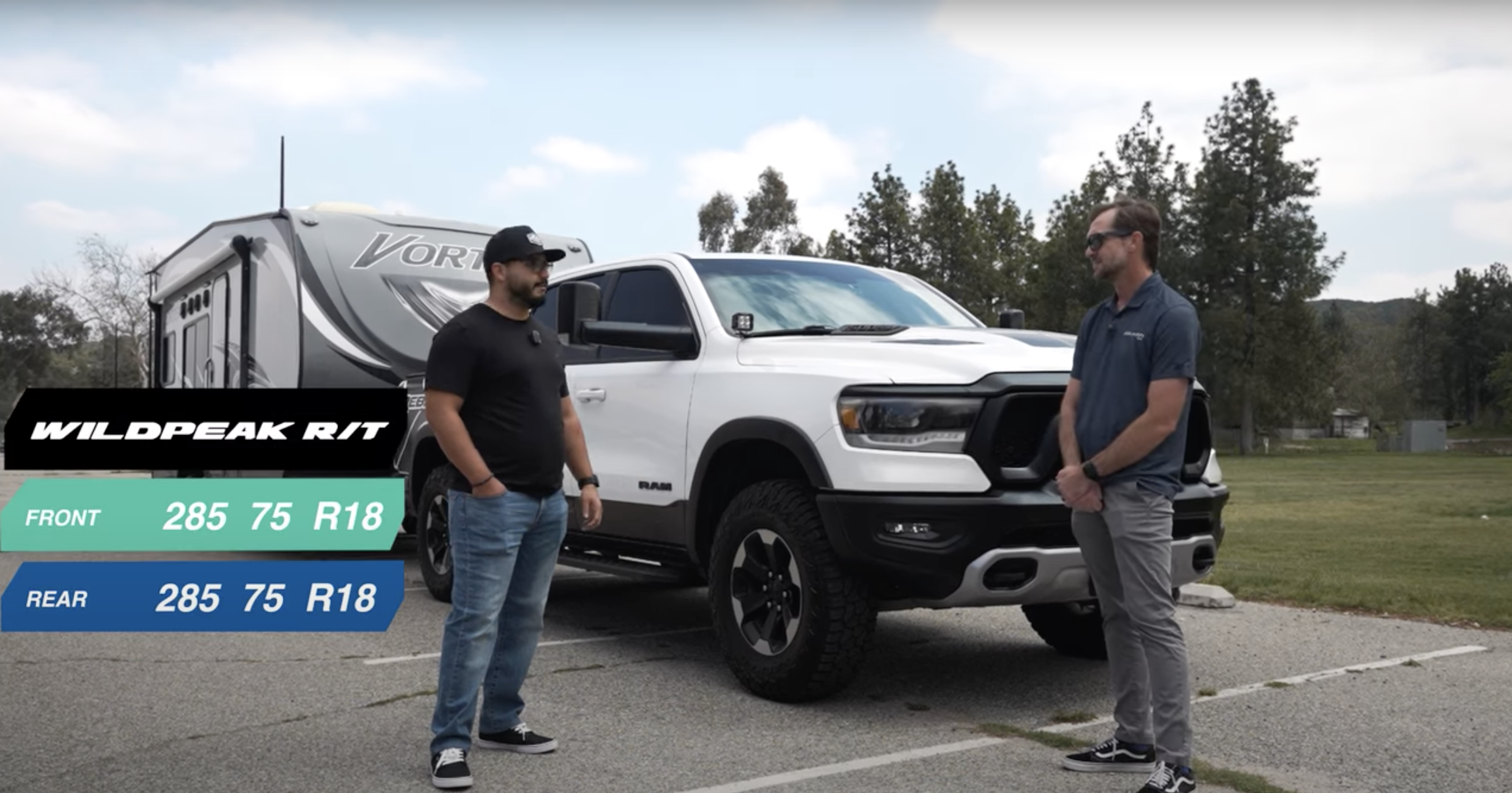
Jeremy: Right. So Eusebio, speaking to the, 35x12.50R17 LT flotation size. Now, this is an LT metric. It's a LT285/75R18. Works out to be just a hair over 35” in overall diameter. But some might call it a pizza cutter because I think it's only a little over ten inches wide. It's just over 11 inches. Just over 11 inches wide. Okay. Yeah. Just over 11 versus the 12.5” which, if you can't tell.
We're back here. We're towing. All that rotational mass and rolling resistance. All that matters when you're towing. So this is a really smart setup for both, looks and aesthetics. And then, making towing a little bit easier on yourself because, you know, it's a big truck. This is a 5.7L Hemi. We got, what, a 24 - 25 foot trailer behind us?
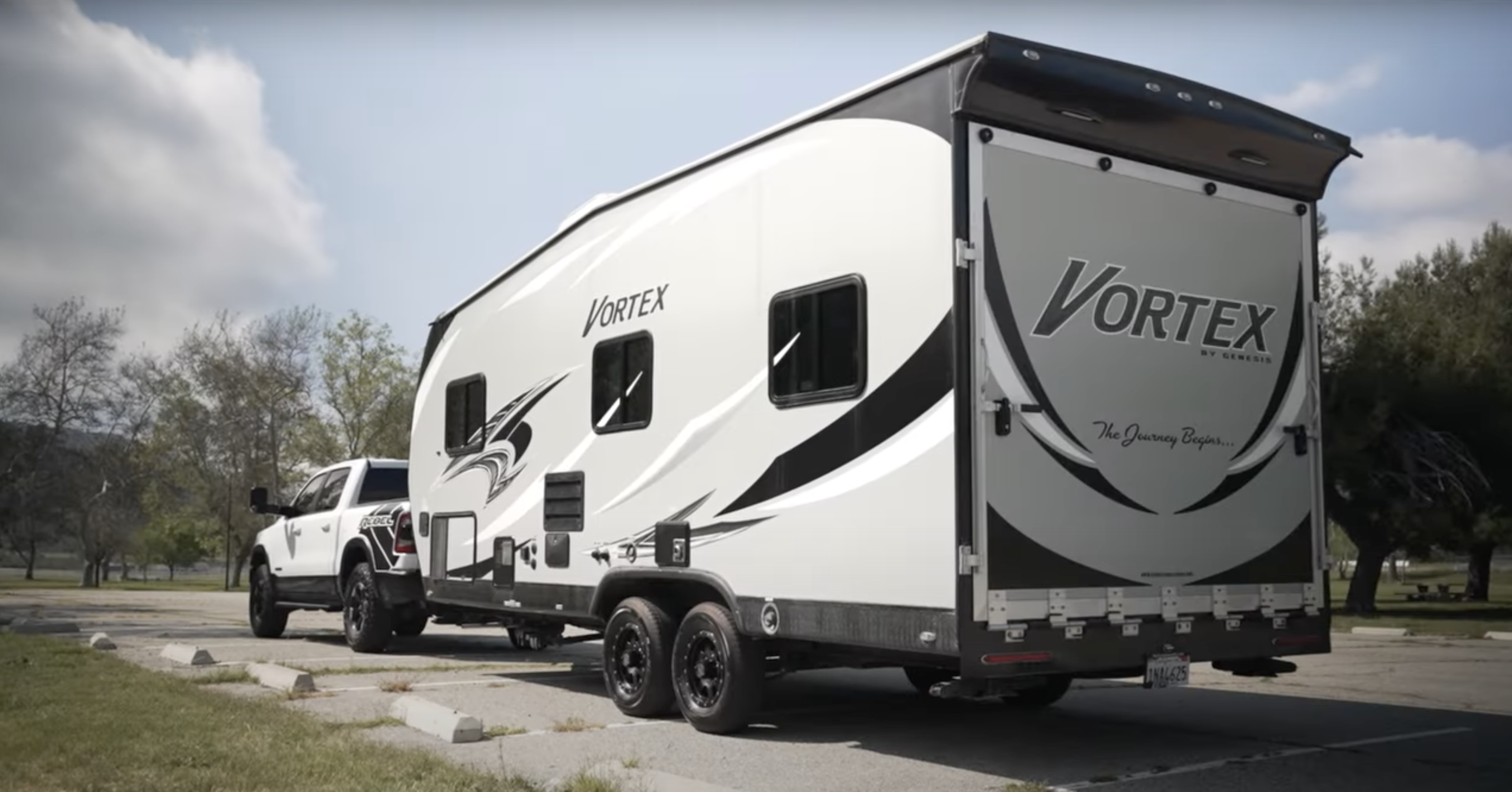
Yup, 24.5'. And he hauls toys in it, so there's a lot of weight involved. So that was going to be one of my questions, was about what makes the Rebel different mechanically. So we've got a one inch lift on it already. Now did you have to lift it any further than that?
Eusebio: I do have a two inch leveling kit in the front. And that's done via the aftermarket suspension. So on this, there's actually the Terra Flex Falcon shocks in the rear and the Terra Flex Falcon Struts in the front. Okay. They are adjustable so you can leave it anywhere between your stock factory height or increase it up to a maximum of two inches if you choose to. Which is kind of what I've done to this one. So when you adjust that setup does it make the front end stiffer or is it literally just a height adjustment? No. This one, it was literally just the height adjustment. I wanted a little bit more clearance because I knew that, I was eventually going to be upgrading to a bigger, taller tire.
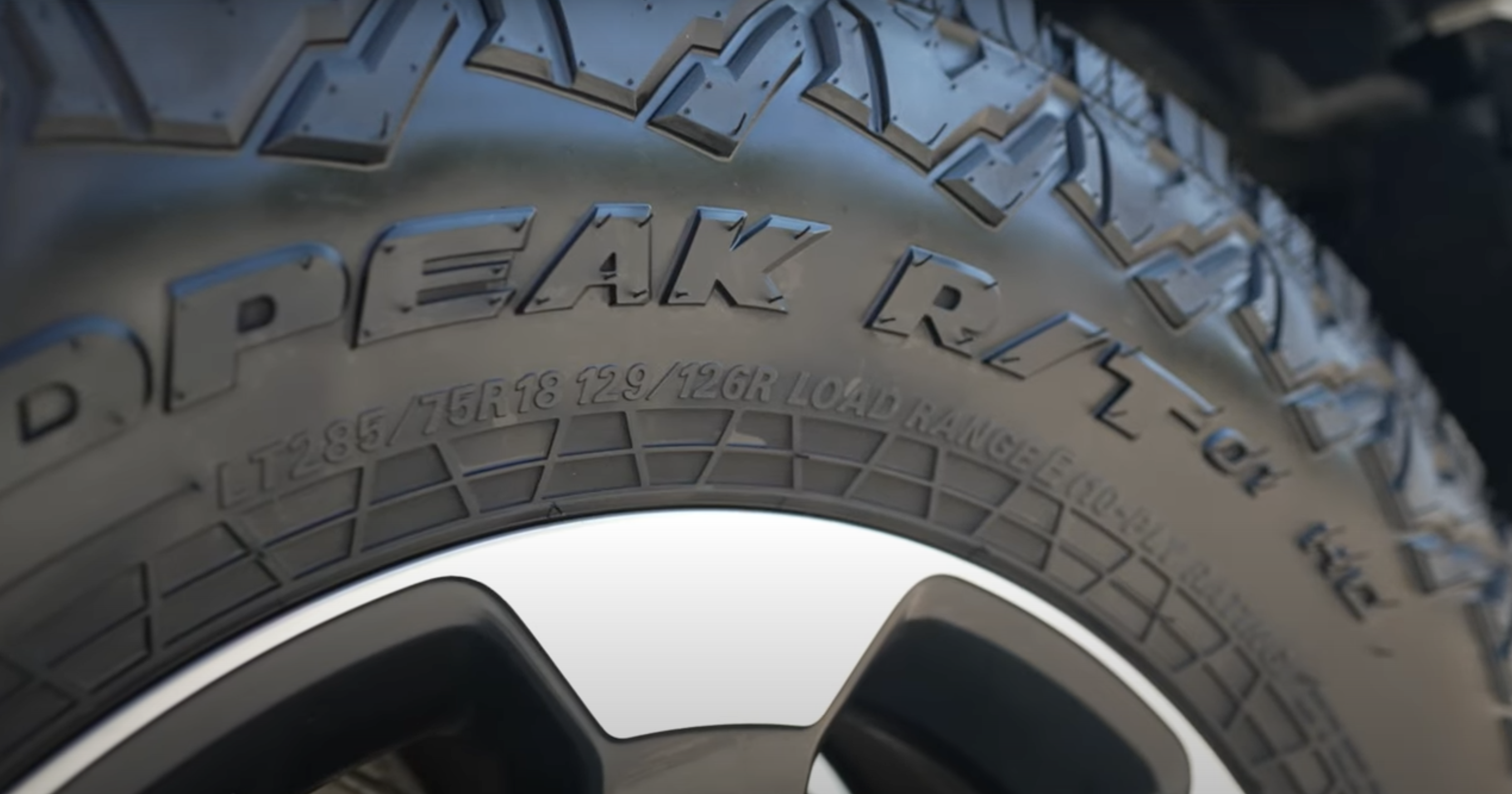
LT285/75R18 vs. 35x12.50x17 Tire Size
Eusebio: I think initially I had thoughts of doing the 35x12.50 but that would have required me to have also upgraded the rims and the wheels and gone with a wider rim base. And, me personally, I like the stock rims, but this tire not only gives me that 35 inch height, but it also gave me the flexibility to keep the stock wheels on here for as long as I wanted to.
Jeremy: Right. So back in the day, you know, trucks, cars they came with plain steel wheels, maybe a hubcap, if you're lucky. But honestly, the OEs have really stepped up their game in terms of wheel styling. So I hear you, it's a good looking wheel. And why change it up? Right? The one downside to some stock wheels is the offset, which is why Eusebio wanted to go with that thinner tire, because he would have required, more negative offset if you wanted to run that traditional 35x12.50.
So by doing so, he keeps the wheels where they were meant to be. Just tucked in the fenders here, which also helps with aerodynamics and whatnot. And I assume it's not rubbing. Right. Is that a good assumption? Absolutely right. It's lock to lock. No rub, absolutely none. No, that's awesome.

Wildpeak R/T (Hybrid Terrain Tire)
Jeremy: We talked about why you chose the size, versus, traditional 35x12.50R17. Why did you pick the Wildpeak R/T?
Eusebio: So, stock. I believe these come with the Goodyear Wrangler DuraTrac tires, and I guess when we're just doing just soft off-roading, they do. But, you know, being in Falken working at Falken and then having some of the perks that we have, after, I think I got to 50,000 miles on the truck and it was just time to replace and start those upgrades. At the time, we still had the A/T3W, and these were just in the middle of getting rolled out to the general consumer.
Once I started to explore whether I would upgrade to the A/T3W or the R/Ts, it had more to do with what I was doing at the time and what I was going to keep doing more. So then, kind of what would have been the best natural upgrade from an All-Terrain to an All-Terrain?
So I was doing a lot more off-roading in the dunes on the side-by-sides that I load up on the toy hauler. And there's a lot more soft sand there. This kind of, having the bigger wheel, reducing some of the air pressure that's in there, airing down, getting a little bit more comfortable there in that kind of terrain.
And then when we're going to like Ocotillo Wells or whether it's Stoddard Wells where you get a little bit more of those sharp rocks, having the R/Ts that has a little bit more, bulkiness to it, a lot more tread depth, a little bit more of a true hybrid tire that gives you more flexibility from those pointy rocks, those sharp objects that are going to be consistently poking through you when you're reaching those trails.
I mean, this just kind of fit all those bells and whistles that I was looking for in a tire that's going to make sure that I get from point A to point B, having my kids riding in the back knowing that I'm going to get to that point A to point B safely.
Jeremy: Right on. And so for those that aren't familiar with the WILDPEAK R/T, it's kind of a hybrid in between an M/T and an All-Terrain, really just fills that gap, you know, falls somewhere in the middle. Like Eusebio was saying you get a more aggressive tread pattern than you would with the All-Terrain. But not quite as aggressive as an M/T. You do get some of these aggressive shoulder lugs, like an M/T. And we've got some really aggressive upper sidewall design that does help in those low pressure situations. But another thing that Eusebio spoke to is this three ply DURASPEC sidewall.
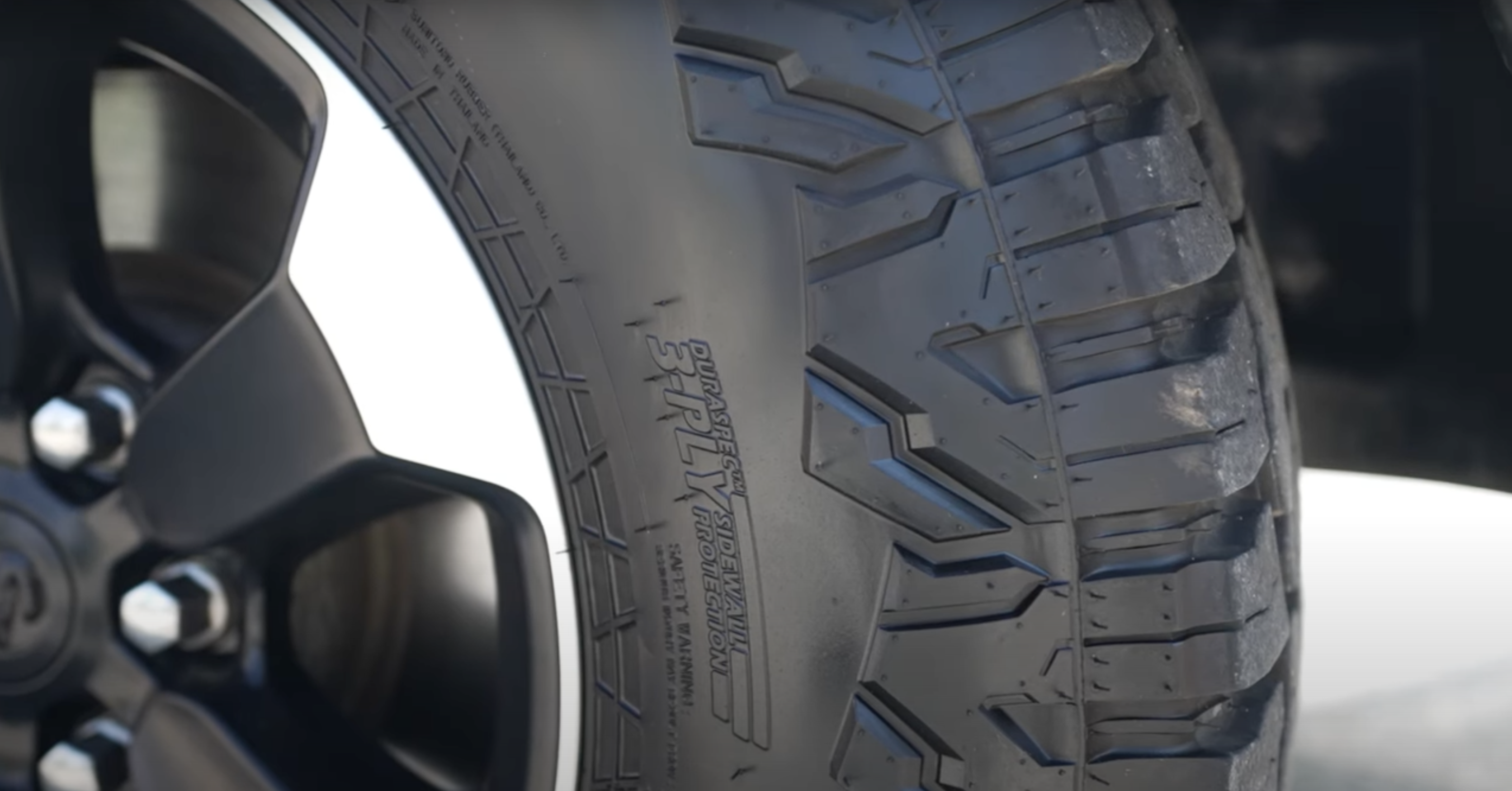
So this technology came from our WILDPEAK M/T line. It's three plies thick no matter what the the ply rating says on here, that's not true. So this isn't actually a ten ply tire, even though it's a E ten ply. It's a three ply sidewall, which does help with that puncture resistance and overall durability.
Effects of Changing from RAM 1500 Rebel Original Tire Size - 275/70R18
Jeremy: Do you remember the overall diameter of the stock tire? Yes, it was a 33x11. Okay. So it's, 275/70R18. Okay. Exact stock size. So by going up to what amounts to being a 35, you've gained one inch of ground clearance. You know, everything that's underneath the truck, and how was the drive after going up to a bigger tire?
Eusebio: So at first, I actually thought it was going to be a significant change because it is a lot more weight. You know, having that extra inch and a half in tire, plus the added, I believe it's, maybe added about 10 pounds per tire as far as that rolling mass. Yeah. But if I'm being honest, I mean, there's very negligible change.
It's nothing that I've been able to notice and say, oh, this is so much rougher, so much stiffer. The tire itself, it's extremely quiet. My kids will be dead asleep in the back and they have no idea. When we finally get there, they finally wake up. And, you know, it just rides very, very well.
You can easily mistake it for a stock tire that's supposed to come out of the dealership. That's supposed to be plush and quiet and or a highway terrain tire. It just really it has no noise, no road noise. It helps to have a loud exhaust, too. But, I mean, even without it, it's still, like I said.
Jeremy: So the 2020 has an eight speed transmission? Yeah. So that really helps to close up those big gaps between gears on older five and even six speed transmission. Heaven forbid you get a four speed, because then you'd be really hurting. But that helps make the difference. Does the Rebel come with a different rear end, differential ratio than the standard 4x4, you know?
Eusebio: No. It doesn’t. So this is the same edition that's what they call the Rebel or the Big Horn with the off road package. The difference is just in the ride height. My understanding is they just come with an extra inch from factory, so that just increases the coils that come with the truck. They're just an inch higher.
But other than that, I mean, the differentials and the suspension is all the same. They all come with the Bilstein 4000 series straight from factory.
Ensuring Tires Can Support Truck Towing Capacity
Jeremy: Okay. Well, so we're talking about towing. We're talking about the tire. We got an E10 rated tire here, so that's more than enough for this truck. What is the max tow rating of this truck? Do you know?
Eusebio: Yes, it's about 10,500 pounds.
Jeremy: Okay. And so when you've got your trailer, you've got full tanks of fresh water, you've got propane, you've got all the toys, you've got the food and everything. Do you know how much this trailer weighs? End of the day, fully loaded.
Eusebio: If I had the four door side-by-side in there with 100 gallons of fresh water, 40 gallons of fuel, the 20 pound or two 20 pound propane tanks, plus the food and beverages, kids beverages, of course, that we put in the fridge. It maxes out at about 8,500 pounds.
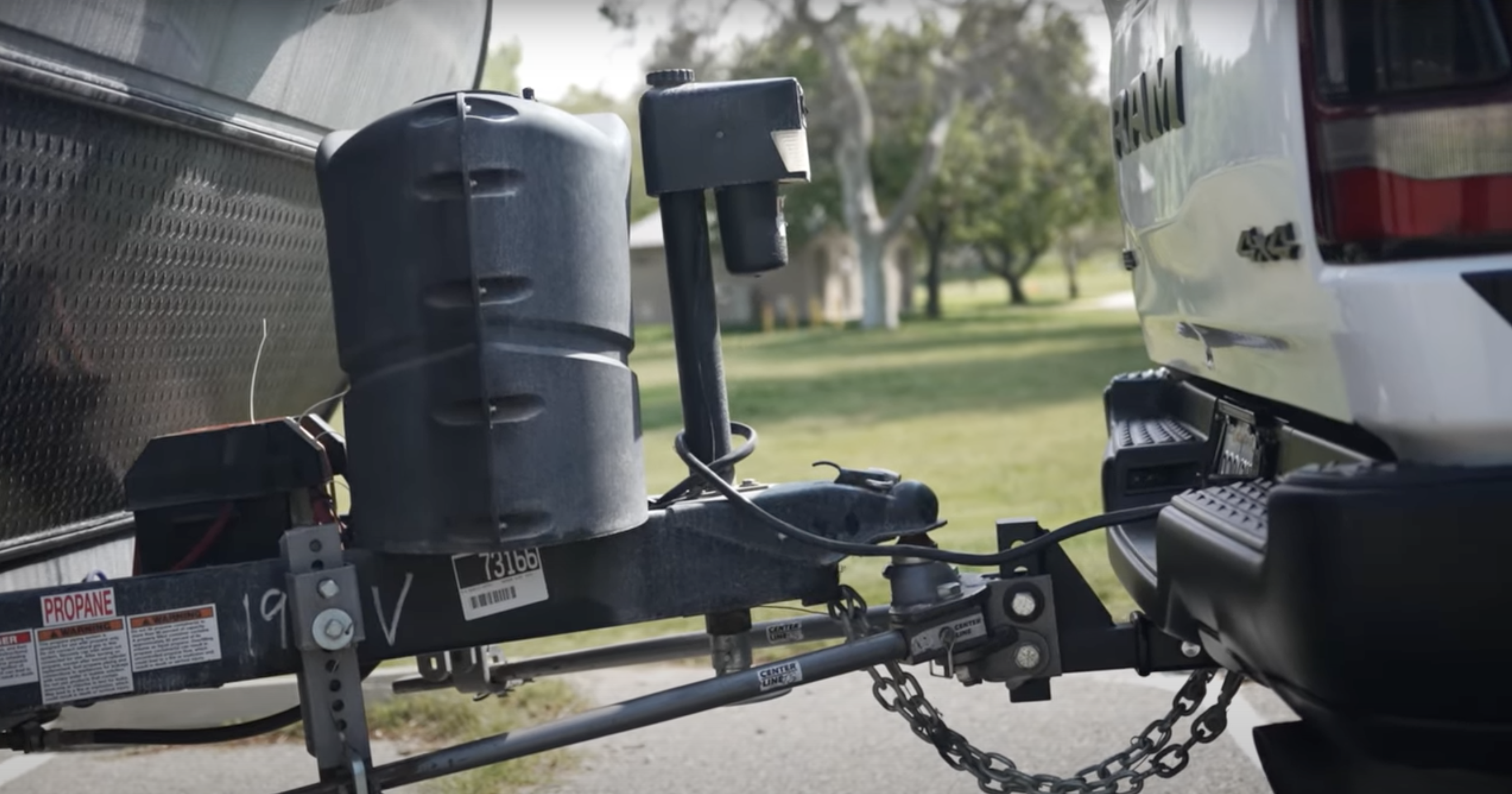
What Else You Can Do to Make Towing Easier
Jeremy: Okay, so then it's within the capability of this truck. But do you feel like the truck struggles at all?
Eusebio: Before I did the airbags in the rear, it would sag a little bit more than it does now, even with the weight distribution hitch. I tried to mess with it as much as possible, but I could still see a little bit of a squat.
So there was that concern that it wasn't balanced enough to allow me to have the true braking power that I would normally have in the front. But then after having the airbags installed in the rear, it kind of levels it back up and kind of helps the weight distribution hitch a little bit as well.
And now it's a more level even feel. And it just, it feels a lot more comfortable and riding that way, especially when towing.
Jeremy: Yeah. So to further what Eusebio was talking about here, if your rear end is squatting, taking weight off the front end of your truck, and I don't know the exact percentage, but it's maybe 75% of the braking is done by the front. If I had a guess, 60 to 75%. So when you take the weight off that front, and then you've got weight in the rear, like pushing you, it can make braking dangerous. So getting it level is critical. You mentioned airbags in the back. You want to maybe tell me about those.? Because that's in addition to your aftermarket suspension.
Eusebio: Right. Correct. So this suspension, actually the Falcon Terra Flex, it has adjustable rear shocks, which means that you can change how much or how little it dampens the dampening. When you have it on the soft setting, that's if you're doing a more regular off road trail just with the truck and you want it to be soft. You might not want that excessive stiffness in the back that's going to cause an uncomfortable off road experience.
Jeremy: But let's not confuse damping with spring rate, right? You can't fix spring rate with damping. Correct? No matter how much you crank it up, it doesn't fix the springs because that's where the airbags come.
Eusebio: Yeah. And so with the shocks themselves, having them on the stiffness mode. And again, it does help with feeling like you're a little bit more planted, a little bit more stiff. Exactly. But it wasn't enough. Because, you know, driving it and you can tell that it was still a little bit too unsteady, you know, for my liking. And like I said, I wanted to make it as safe as possible when towing such amount of weight for such a small truck.
Jeremy: Ideally, everyone would just run a 2500 or a one ton truck, but that's not always the case. So you kind of make up for it, right? Drive it daily. So which is where a 1500 is nice. And if you just set it up right, you can still do what you want to do. I mean, you're not hauling horses. You don't have a gooseneck. you're well within your max towing. So why not?
But so without saying the the F-word, what brand of airbags are these? You know what I'm talking about when I say F-word? (Firestone)
Eusebio: No, these are actually Rough Country. Okay, Rough Country airbags. Actually, the running boards themselves are also Rough Country because the stock running boards are plastic. And when you're off-roading, you land on a rock that's going to bend. So, you know, the running boards are Rough Country. Those airbags, Rough Country airbags as well. They're rated for 5,000 pounds each, which is I mean, obviously you're not going to put that much weight on there.
But like I said, that's where instead of having all that tongue weight coming straight onto the axle and coming straight onto those coil springs, the airbags are obviously taking up the bulk of that now.
Jeremy: So is this an auto leveling system or do you manually fill your bags?
Eusebio: No, I have to manually fill the bags. You can add an on board air compressor.
Jeremy: Yeah. No I mean yeah I've looked at it too, but it's like once you've got it set you don't really need to adjust it on the fly. From what I've found, you just set it up, air it up and usually just good to go. And then, we've got the trailer here. This is what they call a bumper pole, even though it's, you know, you've got a receiver hitch back here.
But he's got the weight distribution. Excuse me. He's got the weight distribution bars on the back, which, I'm not totally sure how it works. That's a little bit science-y, but it does help take the weight off the back of the truck and somehow move it to the front. The other advantage to this setup is it also acts as an anti-sway system. So there's other styles on the market that have like chains. And those are mostly just for that weight distribution.
But this style, I have it as well. It actually helps with the sway that you can experience going down the road. Let's say you're doing 55, big rig goes by at 85 and they just kick out this big gust of wind. And that can make your trailer go all over the place. So this setup helps with that.
Tire Pressure For Daily Driving (Not Towing)
Jeremy: So we got different scenarios here. You got daily driving, you got towing, you got off-roading. So let's start with daily driving. What do you run for air pressure in your tires. Does it vary front to back? You run even on all four corners?
Eusebio: Yeah, it actually does vary from front to back. So from factory, and if you were to run the factory tire, the recommended, air pressure is 55 in the front and 45 in the rear.
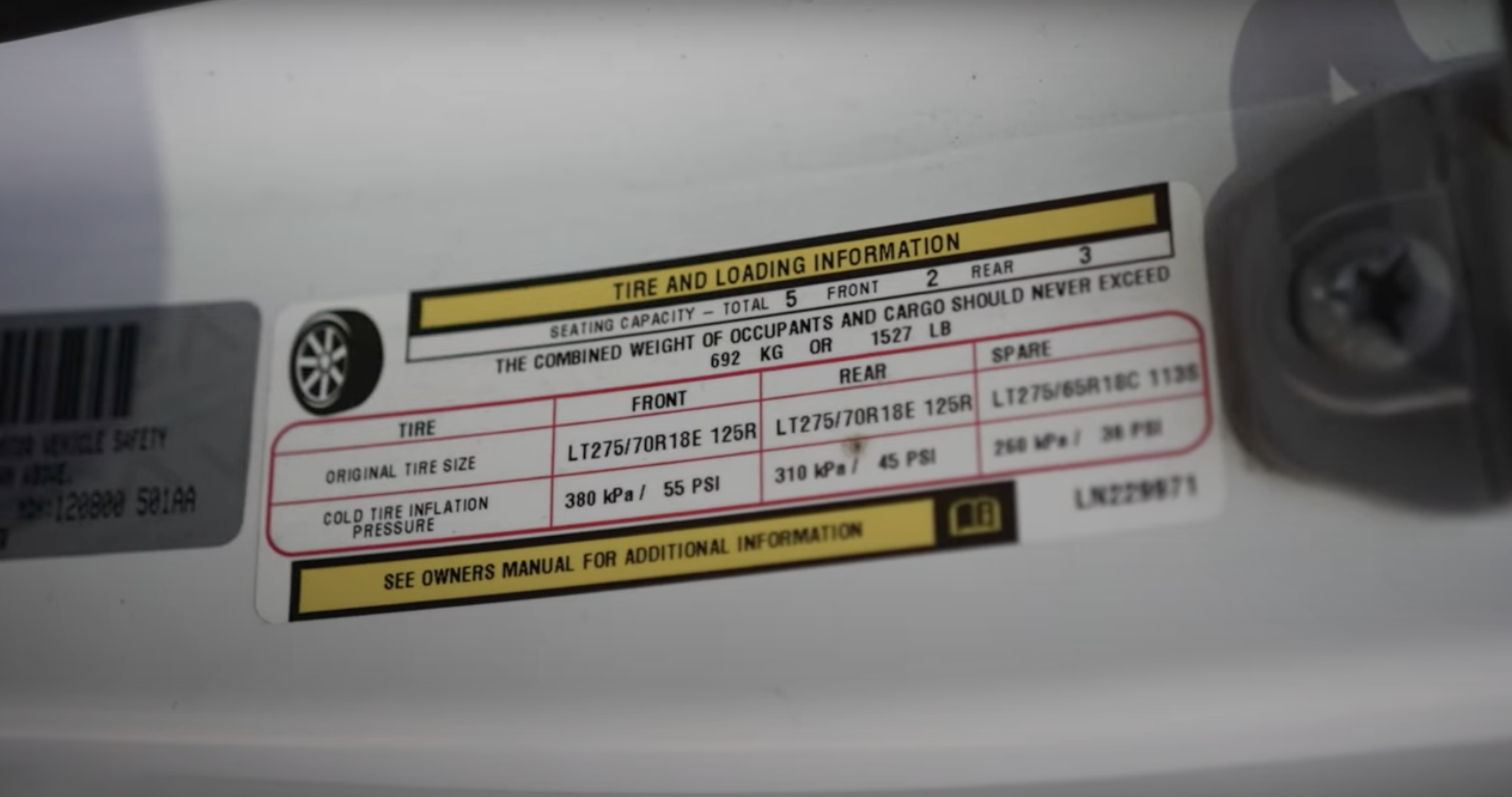
Jeremy: 55 in the front, 45 in the rear?
Eusebio: And that's from factory. Find that on the placard on the door. I was just as surprised as you are.
Jeremy: Because my truck is 40 in the front and 55 in the rear when loaded, but it's 40 all the way around on normal driving.
Eusebio: And I don't know exactly why RAM would come out with such high PSI for factory.
Jeremy: But those engineers determine that that's the pressure you need. So we always recommend staying with that.
Eusebio: That's with stock though. So since these are bigger tires, they're taller tires, right. They're basically the same width, but they are a little bit taller than stocks obviously. I went on tiresize.com to identify what pressure I should be running. Also confirmed with our QA & Warranty team to make sure that you trust but verify, and they kind of came to the same conclusion.
So rather than running 55 / 45, I'm actually running five psi less than what's recommended from factory because of the bigger tire size. So it's 49 and 39.
Jeremy: So to build on that, the volume of air is what supports the load. So the larger tire has a larger volume of air. So it's able to support the same load but with less pressure because of the increased volume. And as Eusebio said, Tiresize.com is an excellent place to figure out all these things. You can plug in your stock tire size, stock pressures, new tire size, and it'll calculate pressures for you. It'll tell you the new revolutions per mile and how that's going to vary from going to that taller tire. And, did you recalibrate your speedometer or anything?
Eusebio: No, that's on on my to-do list. My understanding is it's probably off by 3 to 4mph.
Jeremy: If I had to guess it's probably more accurate now because I found that manufacturers seem to err on the side of caution. And then once you go up to slightly larger tires, it's kind of like, oh, now when you drive past that little radar thing, it's like, yeah, these kind of line up better. So might not even have been necessary.
So now we've covered daily driving. Yep. Towing is a different scenario. When you're towing you got a lot more weight back here. Whether it's in the bed I mean, even in the bed, if you had a lot of weight in the bed, you would want to revisit that tire pressure. But you've got a lot of weight just sitting on the rear end here on the hitch.
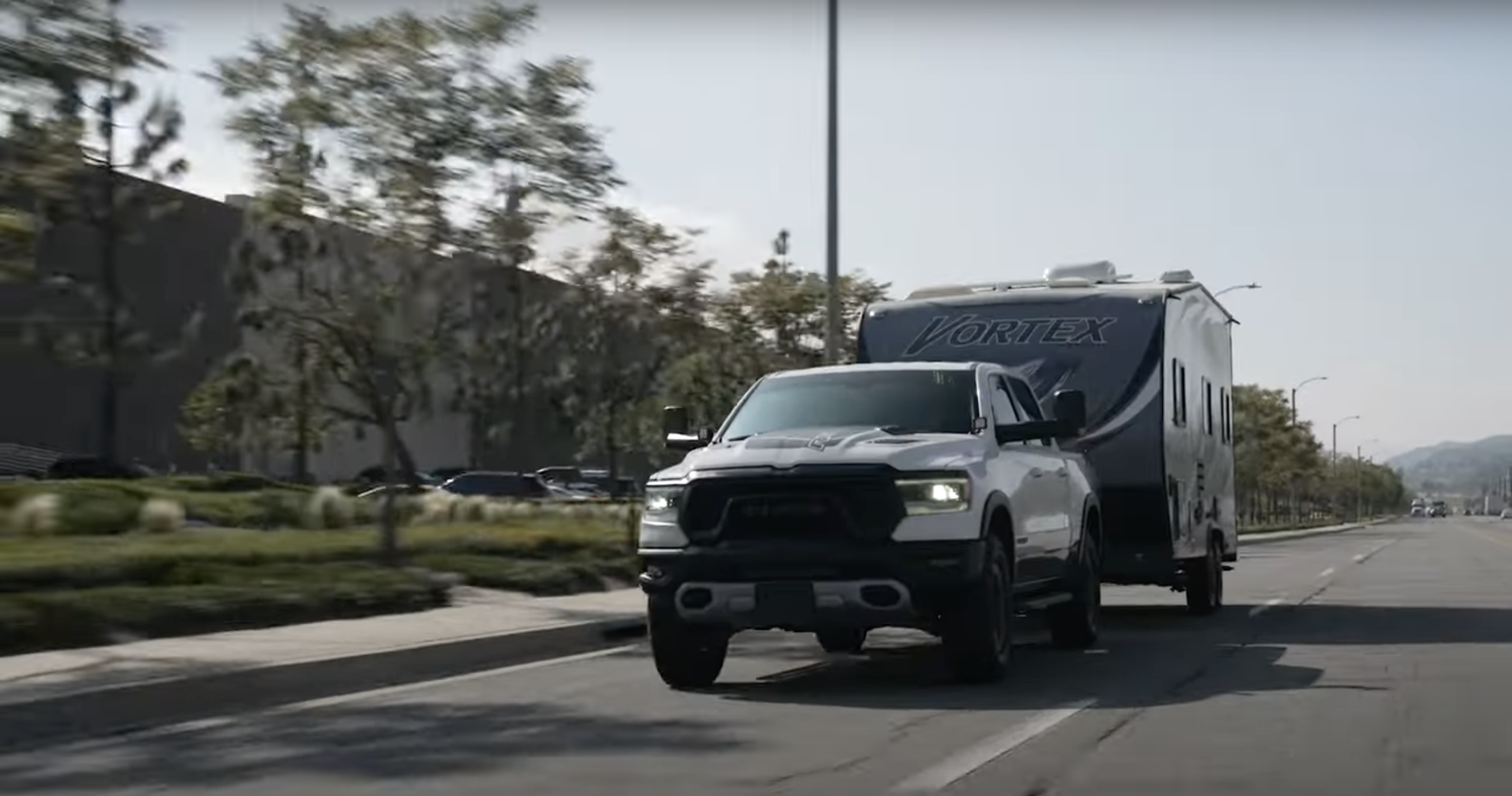
Tire Pressure When Towing
Jeremy: So, what did you determine is your best pressure for towing? Front and rear.
Eusebio: Mind you these tires have a max PSI of 80. I believe I'm not mistaken. So in the front, when I'm towing the toy hauler at full max capacity, which is about 8,500 pounds. I load up the back tire to 60 to 65. And then I'll load up the fronts to 60 as well, what I found to feel more stable as I'm going through the road, especially on the uphills. You know, cornering curves and things like that.
Jeremy: So that wasn't an exact calculation you're able to come by? This is kind of more of a trial and error kind of thing?
Eusebio: Yeah. So if I wouldn't air up at all, you would actually kind of see the tire itself start to come down a little bit if I were to leave it at its stock pressure at 45, because it's a lot of weight that's coming down onto that tongue.
So there's 8,500 pounds that you're towing. I mean there's roughly 850 to 900 pounds that are going straight onto that rear axle as well. And what I found more from a comfort and how I feel the truck as it's rolling, eventually just kind of playing with it and, reaching the gas station, checking the pressures again.
And then if I load up to 60, when I drop all the weight onto that tongue, it actually reads more like 65. Because that weight kind of starts to get applied onto the tire itself. So from 60, it actually moves up to 65. And then since it's actually taking some of the pressure off of the front because you're kind of distributing the weight to the back, that ends up staying more towards that 60 to 59 range by lifting that.
Jeremy: So when you're rolling down the road, you're watching the pressure on your dash and you're seeing as they heat up a little bit, you're seeing that increase. Right? Okay. That's good to know.
Load Range E Tires Needed For Heavy Towing
Jeremy: But again, that's a really good thing to take into consideration, which is why Eusebio chose this tire because of the load range rating. And because of the load range E rating, he's able to increase up to that 80 PSI. If he was running a load range D or even a Load Range C tire, Load Range C, I believe maxes out at 50 PSI, D is 60 or 65 somewhere around there. But anyway, that wouldn't have met your needs. You needed that Load Range E what some people call a ten ply tire mainly for doing what you do.
Tire Pressure When You Off-Road
Jeremy: Now off road is a little different. You want to air down. You know airing down off road does a couple of things. It helps absorb the shocks of the trail. You know, any bumps, imperfections. The trail acts like, additional suspension, makes the ride more comfortable. It also increases contact patch, a little bit by making it wider. But really, what it does is it makes the tire longer. Yeah. So it almost makes it more like a track, you know, like a tank track or snowmobile track. You have to get pretty low to visibly see a difference. But it helps. Yeah. Even as little as five PSI in certain situations can help.
So off-roading what do you air down to?
Eusebio: So I don't do any hardcore off-roading in this truck. It's a half ton truck that I now use mostly to get the true off road cars, to off road. But when I do I don't go anywhere below 25 PSI. Bakari at work actually showed me a chart that kind of shows that as your PSI decreases, the amount of weight and load that that tire can sustain decreases with it. Also why I air up to 60, right? Because you kind of have to follow that trend. I'm in a pattern to how much weight it can hold. So with the truck of this size and of this weight, then anything below 25, and especially not having a bead lock wheel on it, you're really pushing the limit to it. And when you're not doing like gnarly off road terrain trails with super sharp rocks that you're trying to crawl over, it really becomes overkill in my opinion. If you're trying to air down a little bit more than that. I go to 25 mostly for comfort, actually, because if you're in an off road trail with running 40 to 50 psi, it's a tough ride. Oh, yeah. Very. You feel everything.
Jeremy: I think 25 psi is pretty safe. I generally don't recommend anybody going lower than 20 psi unless you're in sand and you really need it. And yeah, to hit on that point, as you reduce air pressure in your tire, your tire is able to support less weight. But we're also talking about off road. We're not talking about highway speeds. We're not talking about that high rotation. So it doesn't heat up the tire as much as it would if you were running 25 psi around on the street.
There's a lot more friction on the ground running that lower pressure, and your tires would heat up, and you'd risk damaging the tire itself, which is why you want to air up once you get back off the trail. But, it's a safe bet when you're off road and you're, like I said, not usually going fast enough to really worry about heating the tire up.
But also, I had a very good visual explained to me one time it was like, think about a helium balloon. Right? By day one, you could stick it with a blade of grass and it popped right. By day two, you can put your finger in it and it's totally pliable, right? So you think about a softer tire versus a hard, fully inflated tire. You get a little bit more puncture resistance as you’re airing down.
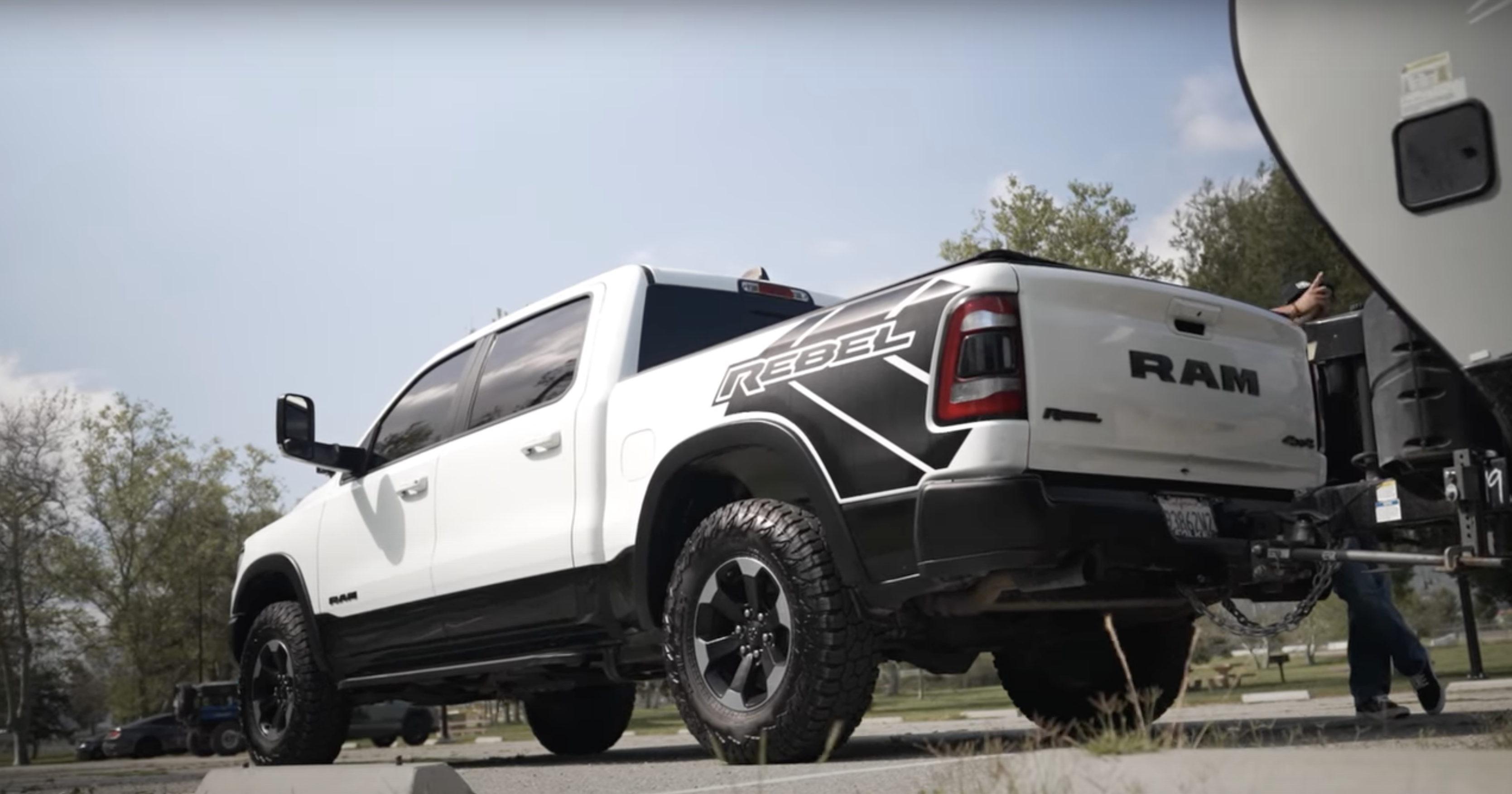
Why Choose the RAM 1500 Rebel
Jeremy: So we kind of talked about, yeah, a lot of people towing something like this would get a RAM 2500. You've taken the time to set this up right. I mean, did you know going into this that a 1500 was going to be on the closer to the edge of its limits? Or is this kind of like you bought the horse before the carriage or the carriage before the horse kind of thing?
Eusebio: Yeah. So I had the horse before the carriage for sure. So before I bought the toy hauler, I already had the off road car, but we were mostly just, when we would camp, we'd just unload the car from the flatbed and then just tent up there. But that kind of limits when you can do that, when you can go camping and having this kind of opens that up, especially in Southern California, whether it's wintertime or summertime, it doesn't really matter.
I mean, if you're inside of this thing and you have the AC going in the summertime or the furnace going in the wintertime, you're still going to be very comfortable as you're inside of that, right? Which for the kids, that's really important.
Jeremy: Oh yeah. Wives too tell me about it. And that's why I had to buy one.
Eusebio: But then when I bought this, that's why I chose what I chose here, because I wanted something that wasn't too small to where it wouldn't have fit a four seat off road vehicle. And this one does because it has a 14.5ft garage, from a toy hauler standpoint. But at the end of the day, it's always just a numbers game. You have to calculate how much of that weight is going to your rear axle. How much total weight you can pull - can sustain the weight of an off road vehicle in the back.
Jeremy: And with all that combined, can your truck have the power to pull all of that? And can you do that safely? And I'm really glad to hear you took the time to figure out all those numbers and really stay within a safe zone because it's extremely common for people to overload their vehicles. Towing a trailer or not, you can easily overload some smaller CUVs just with people and luggage. So, no, hats off to you for taking the time to do all that math and make sure that you're safe and you're keeping others on the road that are driving with you safe at the same time.
So why choose the RAM Rebel 1500 over other trucks on the market?
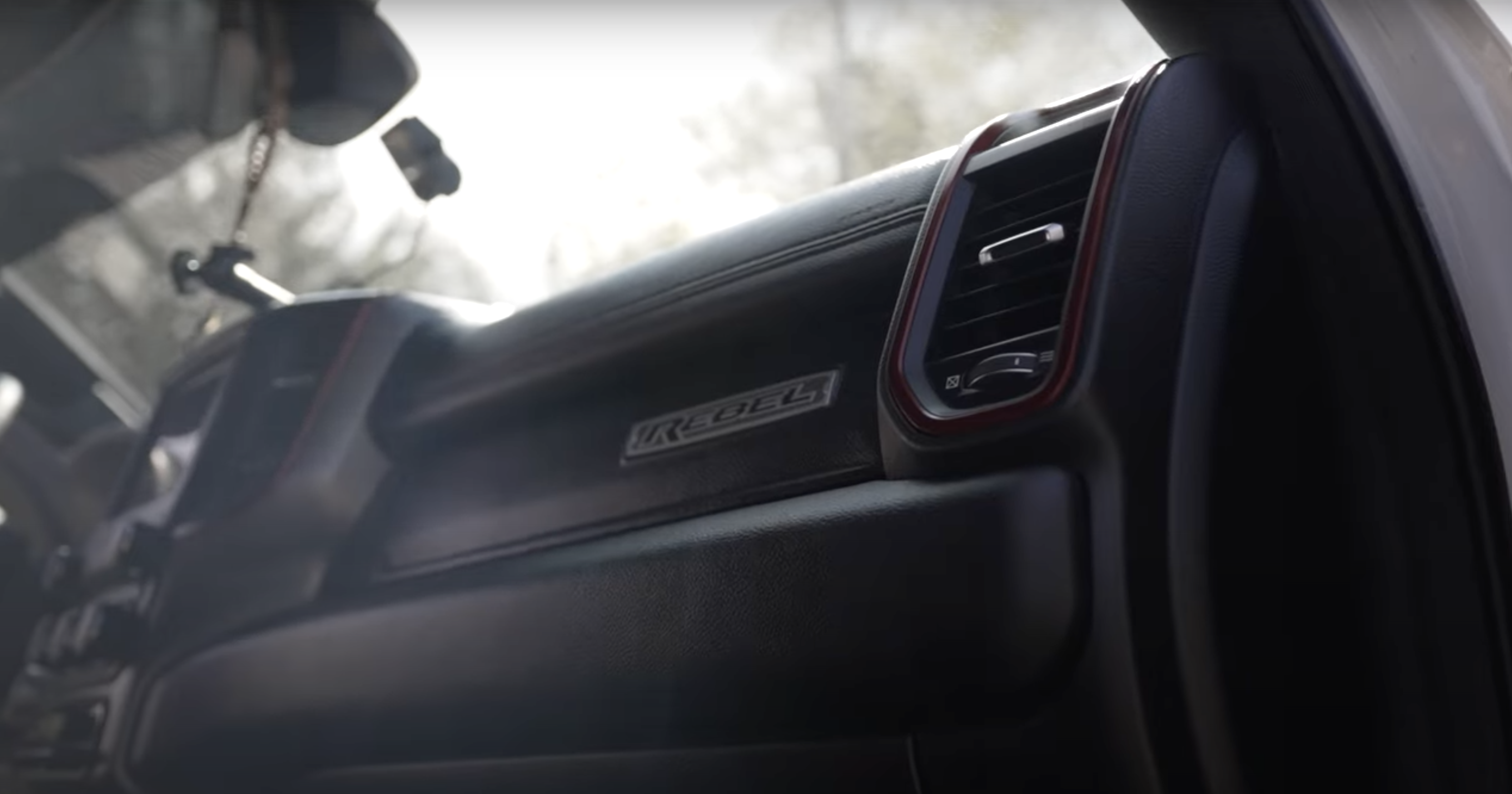
Eusebio: So for me, it had to do with the aesthetics. I mean, just the look of this thing. Both, especially inside, but even outside, I mean, it's just a beautiful looking truck, in my opinion. But the interior that RAM did on these fifth gens is just far above and beyond what you get on any of the other manufacturers.
Jeremy: Yeah. I mean, not to knock any other manufacturers, but if I were in the market right now, I'd be also going for a fifth gen RAM just aesthetically. And, man, that 6.7 Cummins turbo diesel.
Eusebio: That would be, it's tempting on the 2500 right. Rebel. But yeah. I mean, so far this thing's done what it's needed to do.
Jeremy: And at a heck of a lower price point than that diesel 2500 I can guarantee you that. Much better and easier to swallow payment. So, yeah, you chose the Rebel, but there was a version of this truck that came with Falken Tires from the factory that were recently awarded the J.D. Power Award for customer satisfaction. Right? I got to plug that since, you know, got to be proud of yourself, right? Yeah, we all accomplished that. You, me, IT, Marketing. We all did that, but. Yeah. No. Great truck. I love the Rebels they look good. They've got just a little bit extra to make them cool but still be daily drivable.
What MPG Do You Get With Bigger Tires?
Jeremy: And it's a 5.7L Hemi V8, but you've got half your cylinders will shut down. What kind of gas mileage do you get?
Eusebio: Well, because of the bigger tires, and the lift adds a little bit to that. But right now I think I'm getting somewhere around like 13 to 15 miles per gallon.
Jeremy: And that's on your daily drive. And loaded, what do you get?
Eusebio: Oh, if this is fully loaded and then let's say from here to Stoddard Wells, for instance, which is about a little bit shy of an hour, I'm probably getting 8 or 9 miles a gallon.
Jeremy: Yeah. I was going to say, I know that pain you get down in the single digits when you're towing. Yeah, seven, eight, nine, nine if you're lucky. Yeah.
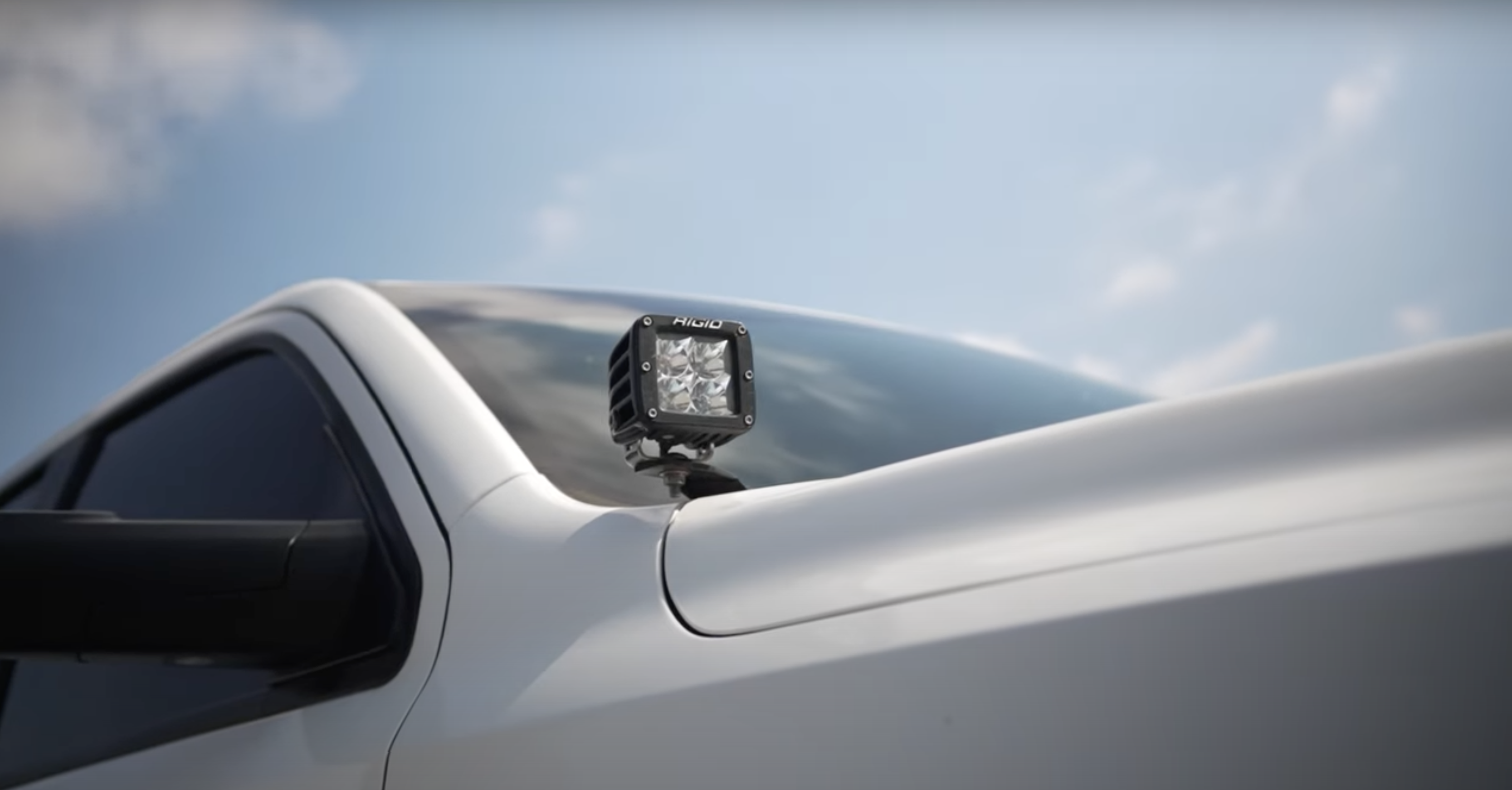
Other Accessories For RAM 1500 Rebel
Jeremy: We talked about suspension, wheels, tires. Are there any other modifications, accessories? I know you spoke to the Rough Country steps there. I see some Rigid ditch lights. Anything we can't see?
Eusebio: Yeah. There's actually a hidden light bar right behind this grill. So because we do a lot of camping, most of the sites that we get to, we get there in the middle of the night.
Jeremy: When you work on a Friday you're going to get there late.
Eusebio: Yeah. So there's a LED light bar hidden behind there. Obviously, you pointed out the rigid lights, the tonneau cover. My kids are in soccer, so having the ability to close that out and having a whole bunch of soccer stuff back there helps, you know, conceal the bag. Everything that I have back there. Then I did the exhaust as well. It's a catback system. So honestly, I don't know how much horsepower, if any, it really gains. It's mostly just for the sound. When you turn on your ignition and you hear that roar. I mean, it's just a smile every morning on the way to work.
Jeremy: You don’t get that out of an Ecoboost. Exactly. Or a Cybertruck. Come on. Let’s be real here. Nothing under the hood, then?
Eusebio: No, nothing under the hood other than I did a switch system that I ran inside in order to wire the lights. and really, that's just about it. Just the tint, that's more for comfort. Like I said, keep the kids cool inside and a dashcam to be able to view the front and the back especially on an off road trail, you want to go back and see.
Jeremy: Did you hook up a camera to the back of your trailer as well? Yeah that's worth it. You should look into it. I don't use it as much as I probably should to kind of warrant those extra kind of things to it, but who knows, maybe one day. It makes a huge difference.
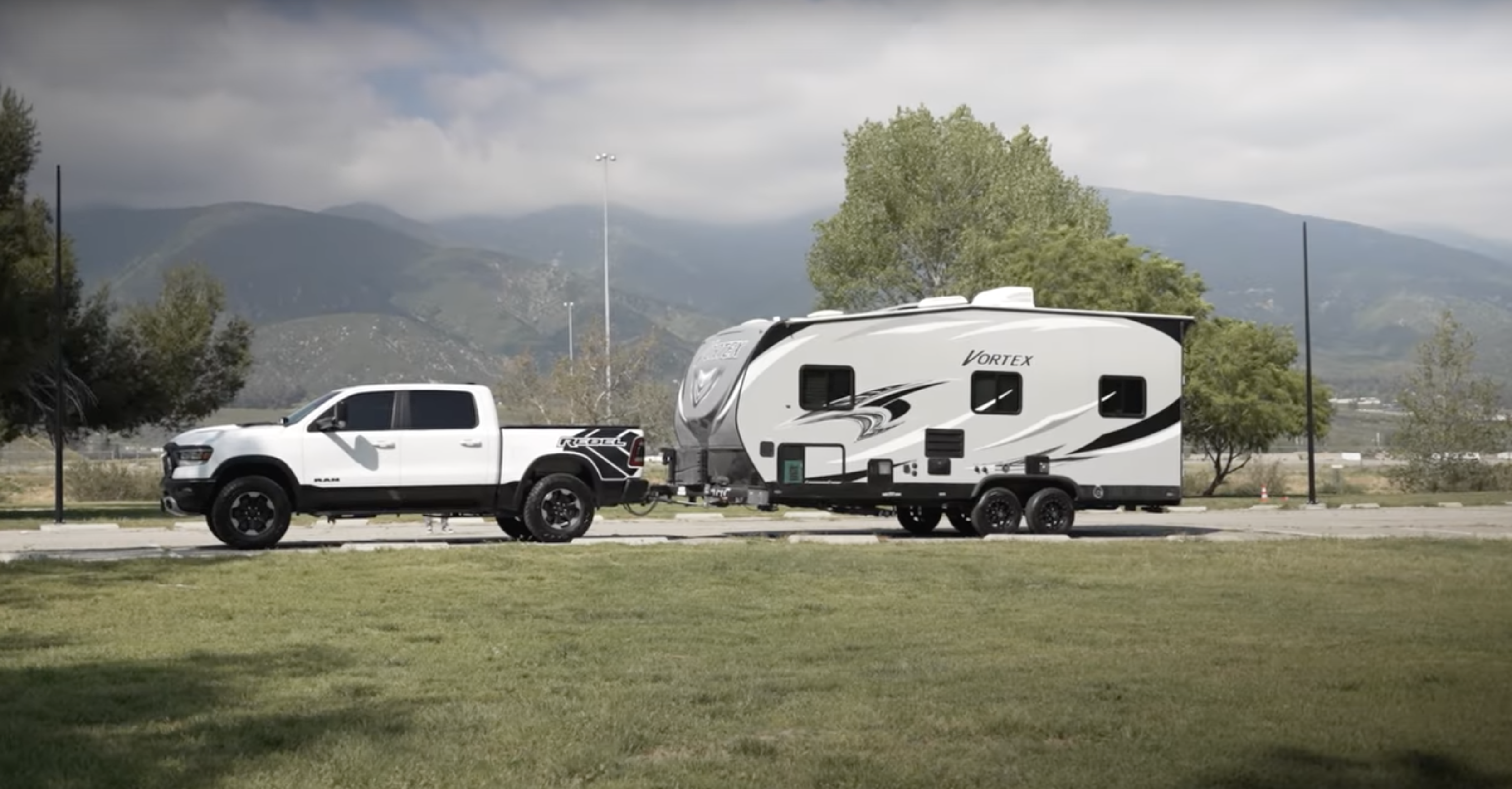
Conclusion
Jeremy: All right, so we're finished up talking to Eusebio from Falken Tires IT department about his RAM 1500 Rebel. We got a lot of comments and DMs and emails, and, I don't know, maybe we got some Snapchats. Who knows? But, yeah, we're always looking for suggestions on what we should dig into next.
What do you want to know? What fits your fill in the blank for us? Please leave it in the comments. Send us an email. Send a DM. Hit up our buddy Max Willy. Whatever it takes. But we're here. This is “Will it Fit?” See you next time.
Suggested
Articles
Browse posts similar to this one.
Sign up for updates
Sign up for our newsletter to stay up to date with the latest Falken news and promotions!
























